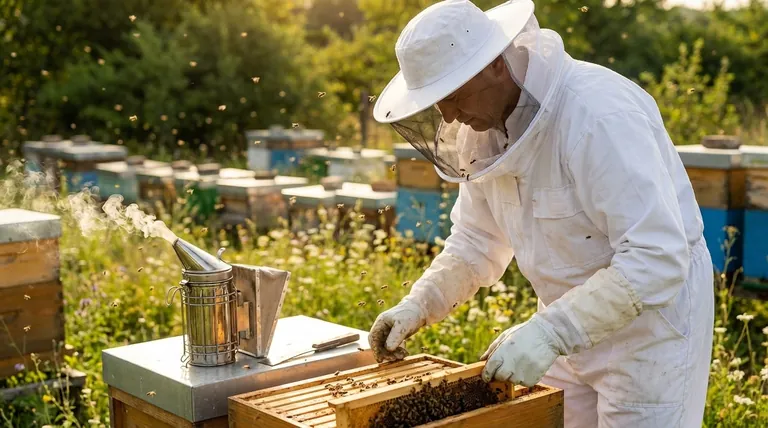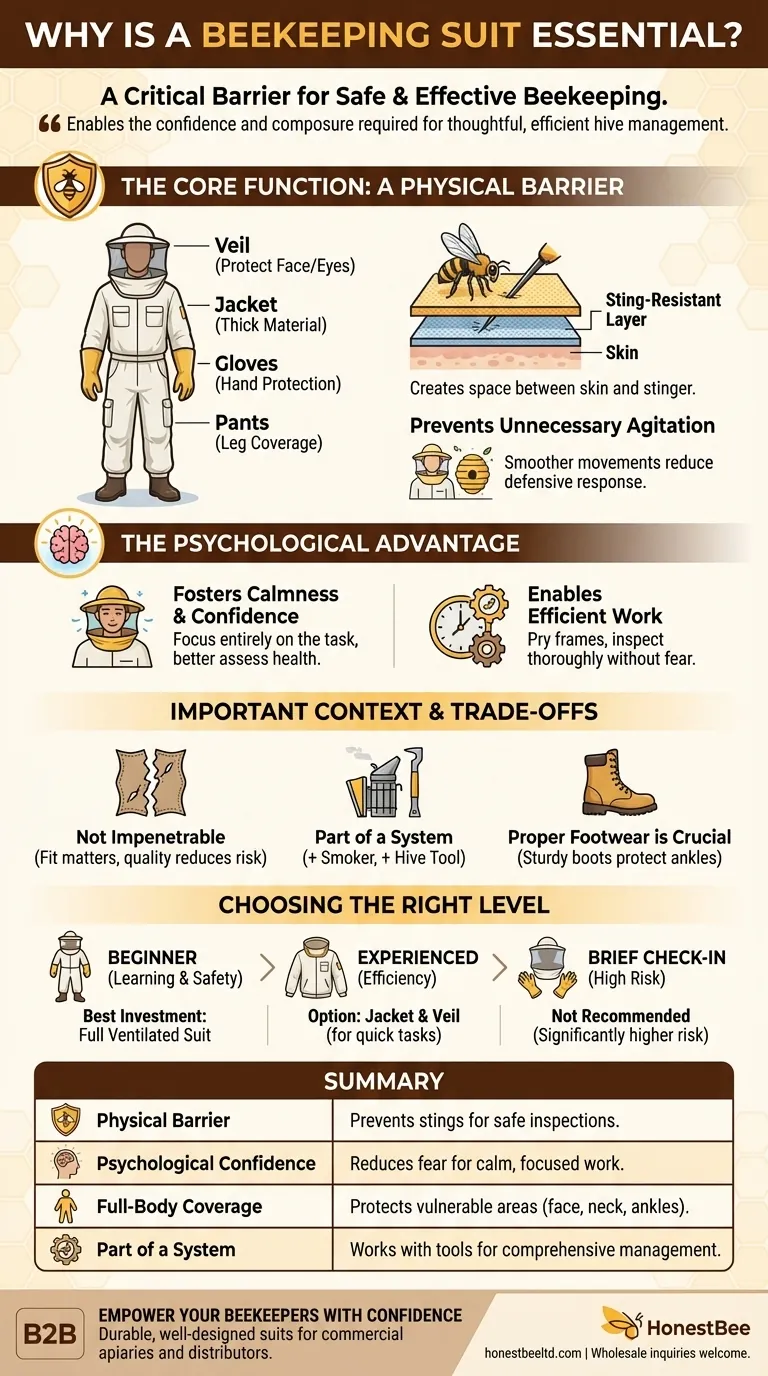At its core, a beekeeping suit is essential because it provides a critical barrier against bee stings. This protection is the foundation of safe and effective beekeeping, as it allows the keeper to remain calm and focused while working with the hives, which is safer for both the human and the bees.
The true value of a beekeeping suit is not just preventing pain, but enabling the confidence and composure required for thoughtful, efficient hive management. It transforms beekeeping from a defensive interaction into a proactive practice.

The Core Function: A Physical Barrier
A bee suit's primary job is to create physical space between your skin and a bee's stinger. This simple function has profound implications for how you interact with a colony.
How a Suit Physically Protects You
A bee's stinger is relatively short. A well-designed suit is made of material thick enough, or layered in such a way, that a stinger cannot penetrate through to your skin.
The Importance of Full Coverage
A complete bee suit typically includes a jacket, pants, gloves, and a hat with a veil. This full coverage is crucial, as bees can target any exposed area, particularly the face, neck, and ankles. The veil is arguably the most critical component, as it protects your eyes and face.
Preventing Unnecessary Agitation
When you work confidently, your movements are smoother and more deliberate. This calm demeanor is less likely to alarm the bees, reducing their defensive response and creating a more peaceful experience for the entire colony.
The Psychological Impact on the Beekeeper
The most underrated benefit of a bee suit is the psychological advantage it provides. Feeling secure has a direct and positive impact on your beekeeping skills.
Fostering Calmness and Confidence
When you are not worried about being stung, you can focus entirely on the task at hand. This confidence allows for more relaxed and thorough hive inspections, enabling you to better assess colony health, find the queen, and identify potential problems.
Enabling Efficient Work
Without the constant fear of stings, you can work more efficiently. Tasks like prying apart frames stuck with propolis or performing a detailed inspection become much easier when you can move with assurance.
Understanding the Trade-offs and Context
While essential, a bee suit is not a perfect solution. Understanding its limitations and how it fits into your overall set of tools is key to responsible beekeeping.
A Suit Is Not Impenetrable
It is important to remember that no suit offers 100% protection. A determined bee can sometimes find a way to sting through fabric, especially if it is pulled tight against the skin. Investing in a high-quality, well-fitting suit significantly reduces this risk.
It's Part of a System
The bee suit is just one piece of essential equipment. A hive tool is non-negotiable for prying apart hive components glued together by propolis, and a smoker helps calm the bees before and during an inspection.
Proper Footwear Is Crucial
Your protection doesn't stop at the suit's cuffs. Sturdy, closed-toed footwear like boots is vital. Shoes with gaps or open toes leave your ankles and feet vulnerable, which can lead to painful stings and disrupt your work.
Making the Right Choice for Your Goal
The level of protection you need can depend on your experience, the temperament of your bees, and the task you are performing.
- If your primary focus is learning and safety as a beginner: A full, ventilated bee suit is your best investment. It provides maximum protection, which builds the confidence you need to learn effectively.
- If your primary focus is efficiency as an experienced keeper with calm hives: You might opt for just a jacket and veil for quick inspections, but you should always have a full suit available for more intensive work or if the colony becomes defensive.
- If your primary focus is a very brief check-in: Some veterans may use only a veil and gloves, but this approach carries a significantly higher risk and is not recommended for most situations.
Ultimately, proper protective gear empowers you to be a better, more observant, and more effective beekeeper.
Summary Table:
| Key Function | Why It Matters |
|---|---|
| Physical Barrier | Prevents bee stings from reaching the skin, allowing for safe hive inspections. |
| Psychological Confidence | Reduces fear, enabling calm, focused, and efficient work with the colony. |
| Full-Body Coverage | Protects vulnerable areas like the face, neck, and ankles with an integrated veil. |
| Part of a System | Works alongside a hive tool and smoker for comprehensive hive management. |
Ready to work with your bees confidently and efficiently?
A high-quality beekeeping suit is the foundation of safe and productive apiary management. At HONESTBEE, we supply durable, well-designed beekeeping suits and full protective gear tailored for the demands of commercial apiaries and beekeeping equipment distributors.
We help you protect your most valuable asset—your beekeepers—ensuring they can perform their duties with confidence and focus. Our wholesale-focused operations are built to support your business's growth and safety standards.
Contact HONESTBEE today to discuss your protective equipment needs and request our wholesale catalog.
Visual Guide

Related Products
- Cotton Beekeeping Suit and Round Hat with Veil Bee Keeper Protective Gear
- 3 Layer Mesh Vented Sting Proof Beekeeping Suit with Hat and Veil
- Vented Beekeeping Jacket with Hood and Veil for Beekeepers
- Yellow Plastic Bucket Pail Perch for Beekeeping
- Heavy-Duty Stainless Steel Clip-On Frame Perch
People Also Ask
- What should be considered regarding the color of beekeeping clothing? Ensure Your Safety and Keep Bees Calm
- How should a bee suit be cleaned? Protect Your Investment and Ensure Apiary Safety
- What factors should be considered when choosing a beekeeping suit? Balance Safety, Comfort & Performance
- What are the benefits of a fully ventilated beekeeping suit? Stay Cool and Protected in Hot Climates
- Do beekeeping suits completely prevent stings? Maximize Your Apiary Safety with the Right Gear



















